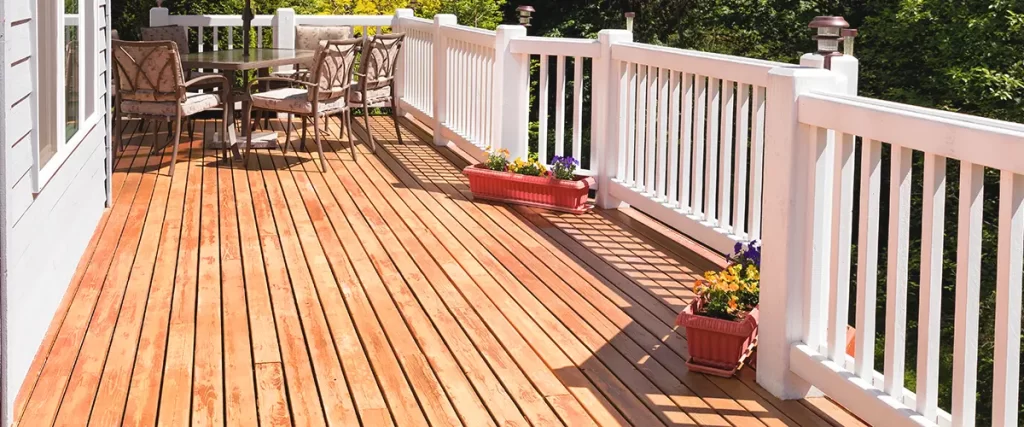When you live in Maryland, the beauty of coastal living comes with a tradeoff—wind. And not just any breeze. We’re talking about hurricane-force gusts that can rip siding off homes, uproot trees, and yes, even tear a poorly built deck clean away from your house.
If you’re a homeowner here, you already know how wild our weather can get. And if you’re thinking about building or reinforcing a deck, now’s the time to think hurricane-resistant.
Let’s dive into everything you need to know about building a deck that can stand up to Maryland’s toughest storms—and come out looking great.

Why Maryland Homeowners Should Take Hurricane-Resistant Decks Seriously
Between tropical storms sweeping up from the Atlantic and nor’easters that come barreling down the coast, Maryland’s climate isn’t exactly gentle. Areas near the Chesapeake Bay, Ocean City, and even inland communities like Annapolis and Waldorf can feel the brunt of hurricane season.
Historically, hurricanes like Isabel (2003) and Sandy (2012) taught us hard lessons about wind damage. Local building codes have since evolved, especially in wind-prone zones.
If you’re anywhere within the Maryland coastal zone or floodplain area, you’ve likely got stricter regulations to follow. But even if you don’t have to go above and beyond code, you’ll want to, especially when it comes to your deck.
Understanding Wind Loads: How Wind Affects Your Deck
High-speed winds apply pressure from all angles—top-down, sideways, and even underneath. This can cause:
- Uplift, which can detach deck boards or even the whole structure.
- Racking, or twisting force that can loosen connections.
- Shear stress, which compromises fasteners and joists.
To prevent this, you’ve got to build with the right materials, techniques, and fasteners that specifically address these wind-induced pressures.
Essential Tips for Building a Hurricane-Resistant Deck in Maryland
1. Use Wind-Resistant Decking Materials
Not all decking is created equal. In hurricane zones, you want boards that won’t warp, crack, or easily detach.
Recommended materials:
- Pressure-treated lumber – Budget-friendly and durable.
- Composite decking – More resistant to moisture and warping.
- PVC decking – Lightweight and highly wind-resistant.
Bonus tip: Go for grooved boards with hidden fastener systems—they hold tighter and reduce lift during storms.
2. Secure Your Ledger Board Like Your Life Depends on It
The ledger board is where your deck attaches to the house. If this fails, your entire deck could collapse.
Best practices:
- Use ledger locks or through-bolts instead of nails or lag screws.
- Flash it properly to prevent water damage, which weakens the structure.
- Ensure it’s anchored into solid house framing, not just sheathing.
3. Install Hurricane Ties and Connectors
This is where windproofing really gets serious. Specialized metal connectors hold your entire deck together like a skeleton of steel.
Use:
- Joist hangers
- Post-to-beam connectors
- Hurricane ties for rafters and beams
- Hold-down anchors at footing connection.
Simpson Strong-Tie and USP Structural Connectors are top names to look for when buying these.
4. Deep Footings and Anchored Posts
Footings that are too shallow can lead to a deck that shifts—or lifts—during high winds.
Pro tips:
- Dig below Maryland’s frost line (30”–36”) to prevent heaving.
- Use concrete footings with embedded post anchors.
- Consider helical piles for maximum wind resistance, especially in coastal or marshy areas.
5. Deck Skirting: A Small Detail With Big Impact
Think of skirting as your deck’s wind deflector. Without it, wind can rush underneath and create lift pressure.
Choose a durable skirting option like:
- Vinyl lattice with framing
- Composite or PVC panels
- Custom horizontal slats for airflow control
6. Choose Wind-Resistant Railings and Secure Them Tight
Deck railings are often the first things to go in a storm—unless they’re properly installed.
What to look for:
- Use stainless steel fasteners that won’t rust.
- Choose metal or composite railings with reinforced brackets.
- Avoid overly tall or wide panels that act like sails in the wind.
Maryland Building Code Compliance and Permitting
Maryland follows the International Residential Code (IRC), with state and county amendments. Coastal and high-wind areas often fall under stricter provisions.
What you need to do:
- Check your local zoning office (like MD DGS) for site-specific wind zone requirements.
- Apply for the correct building permit—deck size, height, and attachment method all impact what’s required.
- Schedule inspections, especially for footings, framing, and final approval.
Best Manufacturers for Hurricane-Resistant Deck Materials
If you want peace of mind, start with brands that are trusted in hurricane-prone regions. These manufacturers design products with wind, water, and long-term durability in mind.
Top Brands to Look For
- Trex® – Industry-leading composite decking with hidden fasteners and fade-resistant technology.
- AZEK/TimberTech® – PVC and composite boards made for coastal climates with high wind ratings.
- Fiberon® – Beautiful wood-alternative decking with a strong focus on structural integrity.
- Fortress Building Products – Metal railings and advanced framing components engineered for high-wind zones.
- Simpson Strong-Tie® – Gold standard in hurricane ties, connectors, and fasteners.

Frequently Asked Questions
How do I know if my Maryland home is in a high-wind zone?
Check with your county zoning or building office, or use FEMA’s Wind Zone map for guidance.
Can I retrofit my existing deck to be more hurricane-resistant?
Absolutely. Upgrading your connectors, adding hurricane ties, and reinforcing your ledger board can go a long way.
Is composite decking better than wood for wind resistance?
Generally yes. Composite and PVC boards are less likely to warp, split, or pull loose in high winds.
Do I need a permit to build or modify a deck in Maryland?
Yes. Always check with your local building authority, as deck permit requirements vary by county.
Final Thoughts: Build Smart, Build Secure
A well-built deck isn’t just about having a nice place to barbecue—it’s about safety, durability, and peace of mind. In a state like Maryland, where storms are part of the seasonal rhythm, investing in a hurricane-resistant deck is one of the smartest home upgrades you can make.
If you’re ready to build or reinforce your deck to stand strong against hurricane-force winds, we’d love to help. Contact us at (443) 926-6996 and let’s talk about your deck building project.
